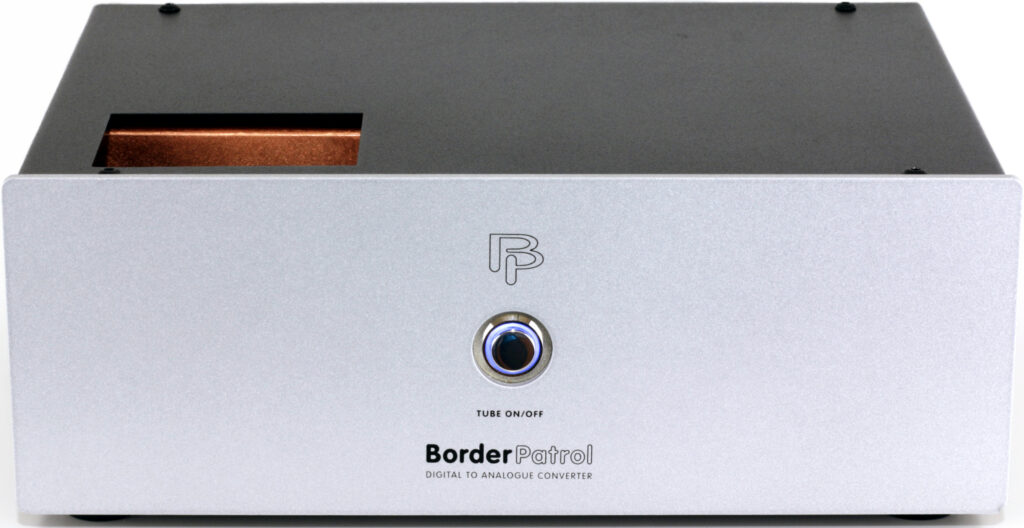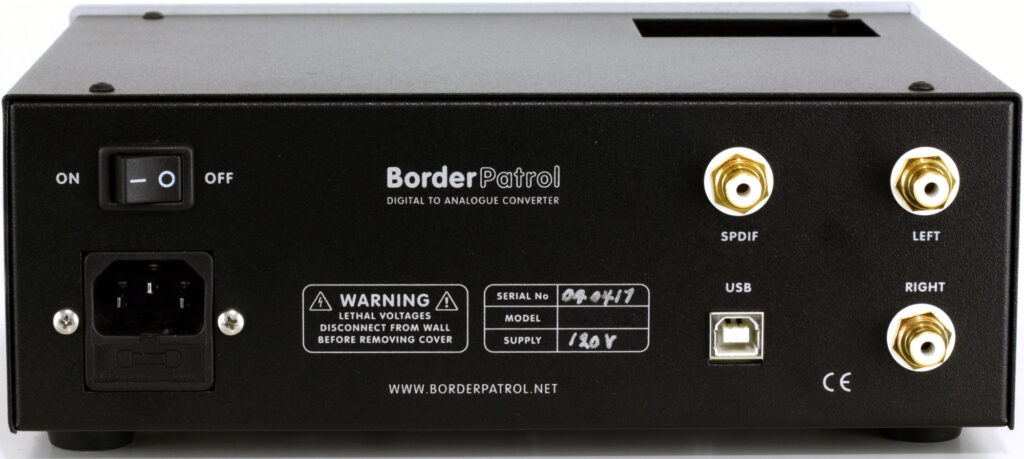Note: Two years ago, my fellow Dagogo staff member, Doug Schroeder, reviewed an earlier model of the BorderPatrol DAC, the SE, which, unlike the SE-i, did not make use of Jupiter Beeswax film and foil output capacitors. Doug did manage to ask Gary Dews of BorderPatrol several questions relating to the philosophy and design of the DAC. That Q&A is integrated into this updated review along with a question or two I added about some of the SE-i’s new additions.
Right out of the box I was expecting this DAC to be somewhat more imposing in size. I marveled at its diminutive footprint — not a bad thing, mind you — as rack space grows dear and I am adding more gear to my systems.
Several people in the Hi-Fi community will refer to gear as being musical, and I take issue with the term being used as such. I much prefer musicality – the quality or state of being musical.
BorderPatrol takes a no-nonsense purist approach to DAC design. The SE-i employs an R2R DAC chip with absolutely no over-sampling, nor is there any digital filtering, and its tube rectified power supply along with its choke set it apart from most DACs currently on the market. This is where I advise readers looking for a DAC that supports MQA and DSD, or that plays back PCM files at resolutions higher than 24/96, to look elsewhere. This DAC is not for you. Conversely, if you can rise above such conventions please do read on.
BorderPatrol’s SE-i makes use of a hybrid tube/solid-state choke input filter power supply with high-speed low noise diodes, over-sized power transformers and a high inductance choke featuring an EZ80 tube rectifier. The tube rectification and choke do set this DAC apart, as this approach is indeed unique in today’s DAC marketplace.
Don’t take this to mean that all options have been withheld. Prospective owners of the SE-i USB/SPDIF will be heartened to learn that they switch between either of the connection and decide where to activate or de-activate the EZ-80 tube rectifier. As the power supply is indeed regulated, and the push-button on the front of the chassis makes activating the tube a snap, leaving the intrepid audiophile to invoke or not. Over time, like Doug, I found myself opting to bypass the tube and pretty much go solid-state.
The DAC chips being put to the test are the venerable Philips TDA-1543 variety that has graced many a CD player/transport, especially back in the day. It is a favorite of many audiophiles, myself included. I do believe it was one of the first things that attracted me to the sound of this DAC. It was/is something familiar. The DAC was not alien to me and I wanted to hear more.
Since DACs can sound precise, detailed, and extreme, there’s something to be said for a DAC that is not and, as mentioned earlier, this is not without compromise. Some months ago, I would have scoffed at the idea, but I found myself wondering why my digital listening sessions never lasted more than a few hours. Now let’s be clear: I am a strong proponent of digital audio, if for nothing else than its convenience as I grow older. Also, I am not one who pits one format over another, ie. analogue versus digital. I am also not looking for digital audio to mimic and/or assume the very qualities and nature of analogue audio and its sound.
My struggle is with the sonic fatigue and a certain tension welling up inside of me from certain digital players that I don’t get while spinning vinyl. To approach this ease with digital audio it became necessary and apparent that I lower my resistance and eschew the common tick-the-box mentality. Once free from the constraints of meeting the requirements of the playback of DSD and super hi-res files in my mind, I, much like Dr Strangelove, learned to stop obsessing and love the musicality.
The purist design of the BorderPatrol brought me back to the sound of my California Audio Labs Icon Mk II coupled with the Audio Note DAC 1. I could and do listen to that combo for hours on end. With the SE-i, I can be there as well, in the knowledge that the SE-i excels in the midrange. This is where the DAC excels sonically. It is not better than others . . . but different. And if the absence of stridency is what one is after, then by all means the SE-i is worth a listen in either its USB, SPDIF or USB + SPDIF configuration. If one Is looking for extreme sonic range, best to move on from here. This is not for you.
I placed the SE-i in all of my systems, including those of both tube and solid-state amplification. And even though the tube component, the EZ-80, is employed for tube rectification and that no tubes are present in its output stage, I preferred the DAC in the system with my PASS Labs INT-250 over the one with my Audio Note I-Zero and ever so slightly more than with my Manley Stingray. If one is to slot this DAC in a system comprised of tube amplification make sure it has the power, the oomph to carry it across the line.
So much of the SE-i’s sonic character comes from the output of the TDA-1543 chips, and their comparative warmth and softness. Again, these are not common attributes when talking of things digital; going to show how far digital audio has indeed come and what has been asked of it.
This time last year I never thought I’d be asking the following rhetorical questions aloud:
- Can music in the digital audio format sound too detailed?
- Can the format’s sonics be physically tension-filled that it is fatiguing, driving the listener to seek shelter in the silence?
- Must digital and analogue sound so different? And if so, is it borne of design/engineering or a foible of the human experience, the base needs to form distinctions?
- Is the desire for perceived perfection in digital audio reproduction destined for the primrose path?
DACs like the BorderPatrol SE-i that use vintage chips and/or tubes in their respective analogue output stages are now clearly on my radar. I have an SW1X DAC here and will be receiving another one in its range later this year. SW1X DACs employ TDA-1541 chips and their analogue output stages are unabashedly tube. I also managed to track down a vintage California Audio Labs Sigma 2 DAC employing a 12AX7 tube and Burr-Brown chips.
The BorderPatrol SE-i in any of its incarnations deserves one’s serious consideration. Its lack of stridency make it hard for me to stop appreciating albums in my digital library.
The SI-I is nice not only for its visible glowing tube, should one choose to invoke, but for its somewhat more adaptive sonic characteristics. Lastly, in considering this DAC, do so suspending both convention and belief, reveling in its unique design and musicality.
- (Page 1 of 2)
- Next page →







I do not have the updated version, but at some point will consider upgrading. I do recommend changing the fuse to Synergistic’s Orange, using IsoAcoustic’s underneath–love the sound. Still not up to vinyl quality, but getting closer.
I have this dac and I love the open and natural and relaxed qualities it exhibits… presently listening for hours with my Bakoon HPA-21 and Sennheiser HD820’s, while reading on the internet. Beautiful little dac.
Hello
Which SW1X dac do you have and how it compares to Border Patrol ?
I’ll be using it connected to Marantz Nd8006 via spdif cable and then to Line Magnetic 845ia with rca cables.